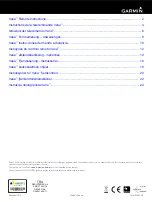
10
The electronic monitoring system uses sensors installed
in a pre-formed slot in the brake pad to allow the status of
the pad wear to be monitored. When the pad wears away
through use, the point is reached when the indicator itself
comes into contact with the rotor.
For
in-pad Normally-Closed Indicators,
when the point
is reached when the indicator itself is worn through, the
circuit flowing through it is broken and the vehicle operator
is alerted.
For
in-pad Normally-Open Indicators,
when the point
is reached when the indicator itself is worn through, the
circuit is completed by the rotor touching the contacts and
the vehicle operator is again alerted.
On some vehicles, the electronic system is fully integrated
into the vehicle monitoring system and uses a buzzer
or indicator lamp to alert the driver. Alternate vehicle
arrangements permit a hand-held diagnostic tool to be
used to test individual wheel connectors, or where installed,
attach to a DIN socket in the dash, and allow up to six
brakes to be checked from that location. The system
provides feedback on the pad wear and can also conduct
a test of the Wear Indicator Potentiometer.
Even when using wear indicators, always follow the
standard preventive maintenance schedule outlined on
page 7.
Refer to the vehicle manual and/or the diagnostic tool
manual for specific device operating instructions.
ELECTRONIC BRAKE PAD WEAR
INDICATORS
13-Pin Plug
(DIN 72570)
to vehicle
Plug for Individual
Wheel Inspection
FIGURE 17 - HAND HELD DIAGNOSTIC TOOL
To Vehicle Electronic
Monitoring System
or for use with
Diagnostic Tool
FIGURE 16 - EXAMPLE OF POTENTIOMETER WEAR
SENSOR
12
Brake Pad Assembly
46 Rotor
11
Pad Retainer
Example of
a Wear Sensor
(101) Installed into
Slot in Brake Pad
101
Wear Sensor
Cable
FIGURE 15 - EXAMPLE OF NORMALLY OPEN OR CLOSED
WEAR SENSOR











































